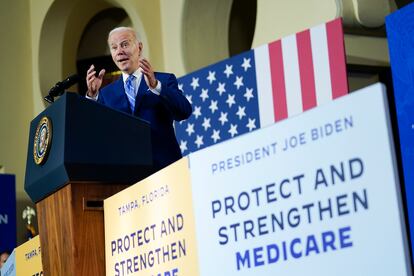What to know about the Social Security cost-of-living adjustment
Tens of millions of older Americans will see a modest increase in benefits in January when a new cost-of-living adjustment is added to Social Security payments

Tens of millions of older Americans will see a modest increase in benefits this January when a new cost-of-living adjustment is added to Social Security payments.
The 3.2% raise is intended to help meet higher prices for food, fuel, and other goods and services. The average recipient will see an increase of about $54 per month, according to government estimates. That’s a smaller percentage than last year, because consumer prices have eased, and the COLA is tied to the Bureau of Labor Statistics Consumer Price Index.
Still, Kathleen Romig, director of Social Security and Disability Policy at the Center on Budget and Policy Priorities, says increased Medicare premiums will “absorb a disproportionate share of the COLA for most people.” One premium is rising by an estimated 6%, or roughly $9.90 a month.
“Seniors and people with disabilities tend to spend a greater share of their incomes on health care, and medical prices are rising faster than overall inflation,” she said, adding that most people will still get higher benefit checks overall.
Here’s what to keep in mind:
How does social security work?
The Social Security program pays roughly $1.4 trillion in benefits to more than 71 million people each year, including low-income individuals with disabilities.
The short answer is that taxes fund Social Security. The government uses taxes from working people to pay benefits to people who have already retired, people who are disabled, the survivors of workers who have died, and dependents of beneficiaries.
While the money is used to pay people currently receiving benefits, any unused money goes to the Social Security trust fund. Some of the money in the trust, together with the Social Security contributions of people in the workforce, pay for future benefits.
To determine what amount of Social Security you’ll receive, the government calculates a percentage of your highest wages from your top 35 years of earning, factoring in when you choose to start receiving benefits.
How is the cost of living adjustment calculated?
The COLA is calculated according to the Bureau of Labor Statistics’ Consumer Price Index, but there are calls to use a different index — one that measures price changes based on the spending patterns of the elderly — like healthcare, food and medicine costs.
“Seniors tend to spend more on medical care in general, including some out of pocket expenses like prescription drug costs, that can be very significant,” said Mark Hamrick, Senior Economic Analyst at Bankrate. “Of course, food, shelter, and energy costs are all still elevated. Those are thing most people cannot go without.”
Is the trust running out of money?
Future problems with the fund have long been predicted, largely because of demographic shifts. As birthrates decline, fewer people become workers, which results in fewer payments of payroll taxes. Meanwhile, more Baby Boomers are retiring and collecting Social Security.
The annual Social Security and Medicare trustees report released in March said the program’s trust fund will be unable to pay full benefits beginning in 2033. If the trust fund is depleted, the government will be able to pay only 77% of scheduled benefits, the report said.
“If you think about the modest decrease this year, the reality is that people would be looking at a more than 20% cut, if the administration fails to address the shortfall,” Hamrick said. “The gospel is, ‘You can’t touch Social Security.’ The longer this problem is unresolved, the less optimal the solutions become.”
Sign up for our weekly newsletter to get more English-language news coverage from EL PAÍS USA Edition
Tu suscripción se está usando en otro dispositivo
¿Quieres añadir otro usuario a tu suscripción?
Si continúas leyendo en este dispositivo, no se podrá leer en el otro.
FlechaTu suscripción se está usando en otro dispositivo y solo puedes acceder a EL PAÍS desde un dispositivo a la vez.
Si quieres compartir tu cuenta, cambia tu suscripción a la modalidad Premium, así podrás añadir otro usuario. Cada uno accederá con su propia cuenta de email, lo que os permitirá personalizar vuestra experiencia en EL PAÍS.
¿Tienes una suscripción de empresa? Accede aquí para contratar más cuentas.
En el caso de no saber quién está usando tu cuenta, te recomendamos cambiar tu contraseña aquí.
Si decides continuar compartiendo tu cuenta, este mensaje se mostrará en tu dispositivo y en el de la otra persona que está usando tu cuenta de forma indefinida, afectando a tu experiencia de lectura. Puedes consultar aquí los términos y condiciones de la suscripción digital.
More information
Archived In
Últimas noticias
Alain Aspect, Nobel laureate in physics: ‘Einstein was so smart that he would have had to recognize quantum entanglement’
Imelda Castro, the woman who wants to rule the cartel battleground of Sinaloa
The new victims of the Republican war on Obamacare: Millions hit by soaring health insurance premiums
A country divided on migrant rights: Some US states expand protections while others restrict them
Most viewed
- David King, chemist: ‘There are scientists studying how to cool the planet; nobody should stop these experiments from happening’
- Reinhard Genzel, Nobel laureate in physics: ‘One-minute videos will never give you the truth’
- Oona Chaplin: ‘I told James Cameron that I was living in a treehouse and starting a permaculture project with a friend’
- Sinaloa Cartel war is taking its toll on Los Chapitos
- Mexico completes its trade shift with the entry into force of tariffs on China and countries without trade agreements










































